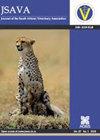Molecular detection of Mycoplasma synoviae and avian reovirus infection in arthritis and tenosynovitis lesions of broiler and breeder chickens in Santa Catarina State, Brazil
IF 0.9
4区 农林科学
Q3 VETERINARY SCIENCES
Journal of the South African Veterinary Association
Pub Date : 2019-11-29
DOI:10.4102/jsava.v90i0.1970
引用次数: 10
Abstract
Infectious arthritis or tenosynovitis in broiler and breeder chickens results in major loss of productivity because of reduced growth and downgrading at processing plants. The most common causative agents of avian infectious arthritis are the bacterium Mycoplasma synoviae and avian reoviruses (ARVs) (family Reoviridae, genus Orthoreovirus). In this study, we evaluated the occurrence of these two pathogens in arthritis or tenosynovitis lesions of broilers and breeder flocks in southern Brazil using molecular detection. Tissue sections from tibiotarsal joints with visible lesions from 719 broilers and 505 breeders were analysed using pathogen-specific polymerase chain reaction (PCR) assays. In breeders, 41.2% (n = 296) of lesions were positive for M. synoviae, 26.4% (n = 190) were positive for ARV, while co-infection was present in 12.2% (n = 88) of the samples. In broilers, 20.8% (n = 105) of lesions were positive for M. synoviae, 11.9% (n = 60) for ARV and 7.7% (n = 39) of these cases were positive for both pathogens. Post-mortem examination revealed lesions with varying degrees of gross pathological severity. Histopathological examination showed intense, diffuse lymphohistiocytic inflammatory infiltrates with heterophil accumulation, primarily in the synovial capsule and digital flexor tendon, in all samples. Improved strategies for early detection and control of these major avian pathogens are highly desirable for preventing the spread of infection and reducing economic losses in the poultry industry.巴西圣卡塔琳娜州肉鸡和种鸡关节炎和肌腱滑膜炎病变中滑膜支原体和禽呼肠孤病毒感染的分子检测
肉鸡和种鸡的传染性关节炎或腱鞘炎会导致主要的生产力损失,因为它们在加工厂的生长速度下降和等级下降。禽传染性关节炎最常见的病原体是细菌滑膜支原体和禽呼肠孤病毒(呼肠孤病毒科,正呼肠孤病毒属)。在这项研究中,我们利用分子检测技术评估了这两种病原体在巴西南部肉鸡和种鸡关节炎或腱鞘炎病变中的发生情况。采用病原体特异性聚合酶链反应(PCR)方法,对719只肉鸡和505只种鸡可见病变的胫跗关节组织切片进行了分析。在繁殖者中,41.2% (n = 296)的病变为滑膜分枝杆菌阳性,26.4% (n = 190)的病变为ARV阳性,12.2% (n = 88)的病变存在合并感染。在肉鸡中,20.8% (n = 105)的病变为滑膜分枝杆菌阳性,11.9% (n = 60)的病变为ARV阳性,7.7% (n = 39)的病变为滑膜分枝杆菌阳性。尸检显示病变有不同程度的大体病理严重程度。组织病理学检查显示,所有样本均有强烈的弥漫淋巴组织细胞炎性浸润,伴嗜中性粒细胞积聚,主要见于滑膜囊和指屈肌腱。改进早期发现和控制这些主要禽类病原体的战略对于防止感染传播和减少家禽业的经济损失是非常必要的。
本文章由计算机程序翻译,如有差异,请以英文原文为准。
求助全文
约1分钟内获得全文
求助全文
来源期刊

Journal of the South African Veterinary Association
VETERINARY SCIENCES-
CiteScore
1.50
自引率
0.00%
发文量
23
审稿时长
22 weeks
期刊介绍:
The Journal of the South African Veterinary Association is a contemporary multi-disciplinary scientific mouthpiece for Veterinary Science in South Africa and abroad. It provides veterinarians in South Africa and elsewhere in the world with current scientific information across the full spectrum of veterinary science. Its content therefore includes reviews on various topics, clinical and non-clinical articles, research articles and short communications as well as case reports and letters.
 求助内容:
求助内容: 应助结果提醒方式:
应助结果提醒方式:


